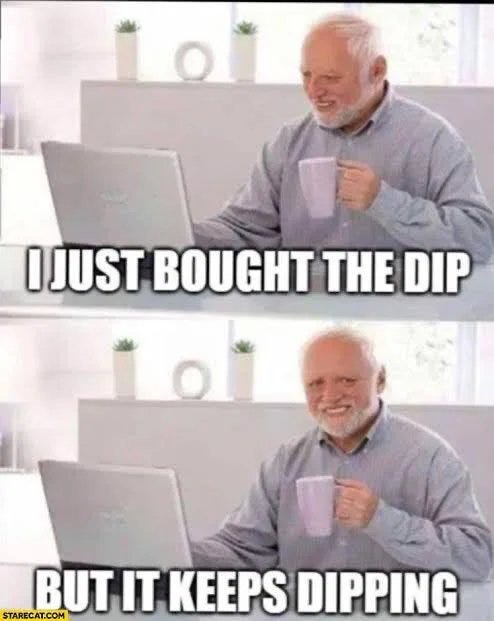I am not writing this post to tout any particular tokens, exchanges, or price predictions. I am writing this post in earnest to share my own personal experiences, hard lessons learned, best practices for security measures, and a guide to all the convoluted abbreviations and definitions used within the crypto community.
I have previously written about central bank digital currencies (CBDC), and may consider a follow up piece to better link the crypto world to the polar opposite (coming soon) world of CBDC technocracy enslavement hell.
It depends on your feedback, readers.
*I am not a bitcoin maximalist, I like some altcoins that have utility, I like precious metals (physical not paper certificates), and I still believe in the importance of preserving cash, as well as turning to barter with localised community networks.

The more ‘black swan’ events we witness demolishing gains of wallet holders on centralised exchanges, the more sentiment is shaken within the crypto industry, and the more palatable the CBDCs will be for the general public – to the point where they are gagging for CBDC roll out and perhaps some ‘free’ universal basic income (UBI) tokens to get the tyrannical ball rolling.
It is a self-perpetuating cycle of governments employing the problem – reaction – solution modus operandi, leading to more and more regulation to ‘protect’ crypto investors, akin to the mythical Ouroboros snake forever consuming its own tail in a never ending cyclical nightmare.

At this point in the game, I imagine that the only crypto holders with all their ‘bags’ held solely on centralised exchanges (as opposed to private keys / hard wallets), are the people who wear masks whilst walking outdoors or when driving their cars alone – so that would be 99.9% of Bangkokians who are into crypto…
CEX: Centralised exchange – meaning there is some level of identity verification process, there are humans managing orders, approving and tracking transactions on the various blockchains, and likely sharing this data with governments on request, or via legal obligations. A CEX is vulnerable to manipulation, ‘front running’ orders, back-door access to the exchange to freeze customer wallets in times of dire liquidity crises, or whatever reason is claimed, whether valid or not.
KYC: Know your customer. Pressure applied by governments, security exchange commission (SEC), and other regulatory bodies, forcing a CEX to ensure their users verify their identity using ID cards, selfie photos, bank accounts, addresses. *Should avoid as much as possible, and seek out reputable smaller CEXs that allow sign up with just an email address and / or phone number (use virtual sim card preferably over your more easily traceable personal mobile phone number).
DEX: Decentralised exchanges – meaning the developer teams set up an exchange governed by algorithms, transparency, and user governance. User governance means that proposals will be put forward by the developers or the users, e.g. ‘Increase the annual percentage yield (APY) by X % for X token’. Users can choose to vote on such proposals using their wallets, their tokens (0.0001 value of given token in most instances; negligible).
A DEX is often ‘open source’, meaning the code is transparent, so that people can see there is no ‘back door’ to manipulate the algorithm, in theory making it more robust against hacking attempts. *This does not make a DEX impervious to hacks, but if and when a hack occurs, all data should be shared with users via twitter, discord, telegram channels etc, and the steps taken to investigate and recover funds.
In almost all instances of this occurring which I have witnessed, any wallets that were hacked are reimbursed by a so called ‘community chest fund’ or other similarly named reserve fund set aside by the core developers.
Staking: If a cryptocurrency you own allows staking —you can “stake” some of your holdings and earn a percentage-rate reward over time.
The reason your crypto earns rewards while staked is because the blockchain puts it to work. Cryptocurrencies that allow staking use a “consensus mechanism” called Proof of Stake, which is the way they ensure that all transactions are verified and secured without a bank or payment processor in the middle. Your crypto, if you choose to stake it, becomes part of that process.
*Staking definition taken from coinbase.com.
Fiat on-ramp: The process for either a CEX or a DEX allowing users to connect their bank accounts to deposit USD / GBP / other currencies to their wallets, in order to purchase cryptocurrency tokens.
DeFi:
DeFi is short for “decentralized finance,” an umbrella term for a variety of financial applications in cryptocurrency or blockchain geared toward disrupting financial intermediaries.
DeFi draws inspiration from blockchain, the technology behind the digital currency bitcoin, which allows several entities to hold a copy of a history of transactions, meaning it isn’t controlled by a single, central source. That’s important because centralized systems and human gatekeepers can limit the speed and sophistication of transactions while offering users less direct control over their money. DeFi is distinct because it expands the use of blockchain from simple value transfer to more complex financial use cases.
BTFD: Buy the f***ing dip – buying tokens at what you think are bargain basement prices, yet might still go much lower…

FOMO: Fear of missing out – when people ‘FOMO in’ as price value rises of a token, often getting wrecked in the process if the value then plummets due to market corrections, whales dumping huge amounts, or other macro economic factors and geo-political factors.
Whale: A crypto investor that holds significant amounts of any given token, can ‘move the market with huge buy / sell orders.

Pump: Price value of a given token increases exponentially.
Dump: Price value of a given token decreases sharply.
TA: Technical analysis – meaning the analysis of past historical trends using charts for any given crypto token, predicting price discovery and whether the token is ‘bullish’ or ‘bearish’. *I am still learning all the sub-phraseology here, so will not delve into this, but will link to some valuable resources at the end of the post.
Bull market: The financial markets for stocks, bonds, and commodities are greatly impacted by consumer confidence. And in bull markets, which occur when investment prices are on the rise for sustained periods, confidence is soaring. Propelled by the thriving economies and low unemployment that usually accompany bull markets, investors are eager to buy or hold onto securities, thus creating a buyer’s market.
Bear market (now): While bull markets are fueled by optimism, bear markets — which occur when crypto / stock prices fall 20% or more for a sustained period of time — are just the opposite. Bulls are generally powered by economic strength, whereas bear markets often occur in periods of economic slowdown and higher unemployment. Instead of wanting to buy into the market, investors want to sell, often fleeing for the safety of cash or fixed-income securities. The result is a seller’s market.
*Bull / bear market definitions taken from citizensbank.com.
Hot wallet: A wallet address that although has a ‘private key’ (special passphrase / seedphrase for you to safeguard), is purely online and more vulnerable to hacking.
Hard / cold wallet: A physical USB-type interfacing device, that keeps your tokens ‘offline’ in ‘cold storage’, can often interface with ‘hot wallets’ such as Keplr and Metamask.
DCA: Dollar cost average – meaning that rather than obsessing over trying to time the markets for maximum financial gain, you don’t think or worry about this, and instead just buy a fixed amount of any given crypto token once a month perhaps (X % of salary, each to their own). The DCA strategy is popular amongst Bitcoin maximalists (people who only believe in bitcoin, and regard all other cryptos as worthless).
As the mantra goes:
Time in the markets, is better than timing the markets.
This list is not exhaustive, yet that will suffice for the sake of this post.
Users should be wary of having too much of their portfolio allocation ‘locked’ in altcoins (anything that is not bitcoin). This may reap great rewards in the short team (in a bull market), via staking, for example. However, the ‘unbonding period’ to make your funds liquid again (and spendable) is often 14 – 28 days as a waiting period – can be a lifetime in the volatile, stressful nature of the crypto markets.
Wariness of being sucked in to high APY / APR percentage yields. Read the whitepaper of whichever token you are considering taking a position in. Find out how many developers are actually still building on the platform.
What utility do they have? For example, a decentralised VPN (could be very important in the future as the control grid closes in). Other promising applications for altcoins consist of decentralised cloud storage (the antithesis to Microsoft’s OneDrive, or Google docs etc).
Final lesson is not to go too heavy on any single asset; be that bitcoin, altcoins, stocks, commodities, or precious metals. Discipline is needed to allocate a large percentage of your portfolio to cash. Take profits on the way up and on the way down. Resist the temptation to reinvest the gains back into crypto.
Consider physical assets like precious metals, and physical real investment resources, such as property, land, planting vegetable gardens, and other preparatory solutions to make yourself more resilient against collapsing supply chains.
In times of crises, when there appears to be no true safe haven, cash is king…until hyperinflation really kicks in, then it’s every man for himself attempting to preserve wealth, rather than accumulate wealth and make gains.
Not your keys, not your coins.
This is the age old adage referenced continuously since the evolution and increased mass adoption of crypto. It means that holding your tokens on a CEX is foolish, as they could go bankrupt, or be ‘captured’ by a governmental regulatory body; the end result is losing your tokens / having them frozen / being inaccessible.
Your ‘keys’ refer to the private keys associated with your private address(es) for various tokens. Custodial hard wallets are prudent, yet keeping the seedphrase / passphrase on a piece of paper is foolish, and vulnerable to theft, damage by fire, flood etc. Purchasing a metal seedphrase wallet (search online for plenty of options), increases your security.
Furthermore, spreading the whole passphrase across multiple metal wallets in multiple physical locations is advisable. This can also be utilised if / when you take the plunge to perhaps entrust parts of your seedphrase to different family members, so that in the event of your death, they can (together) access your ‘crypto inheritance’.
Open source encryption software: I have no qualms about linking to open source software, therefore I would advocate for Veracrypt. The aforementioned best practices are not sufficient to safeguard everything, as you will no doubt have sensitive data including passwords that you want to make more secure and less easily accessible to others who get hold of your devices.
There are plenty of ‘how to’ explainer videos showing how to encrypt any partition (a partial drive on your laptop, or even the entire drive, or a USB / hard drive). Seeking out a type of ‘survival USB drive’ further compliments this practice, i.e. a USB drive that is nigh-indestructible, water proof, shock proof etc.
Password managers: I am reluctant to advocate for any specific providers here, as there has been some bad press lately with various password manager service providers having data breaches. Do your own research and due diligence.
These providers can have utility not just for the sake of storing all your passwords (using a ‘master password’), but sometimes come with a ‘premium feature’ which is a ‘dead man’s switch’.
Meaning, that you could email a link to your account to a family member, and when you die, the family member’s email address can access your account (but only if you do not respond to the email request notification within 30/60/XX number of days).
Nicholas Creed is a Bangkok-based journalistic infidel impervious to propaganda. Follow Creed Speech on substack here. If you liked this content and wish to support the work, buy him a coffee or consider a crypto donation:
BTC: 39CbWqWXYzqXshzNbosbtBDf1YoJfhsr45
XMR:86nUmkrzChrCS4v5j6g3dtWy6RZAAazfCPsC8QLt7cEndNhMpouzabBXFvhTVFH3u3UsA1yTCkDvwRyGQNnK74Q2AoJs6Pt

Source: The Daily Bell Rephrased By: InfoArmed

